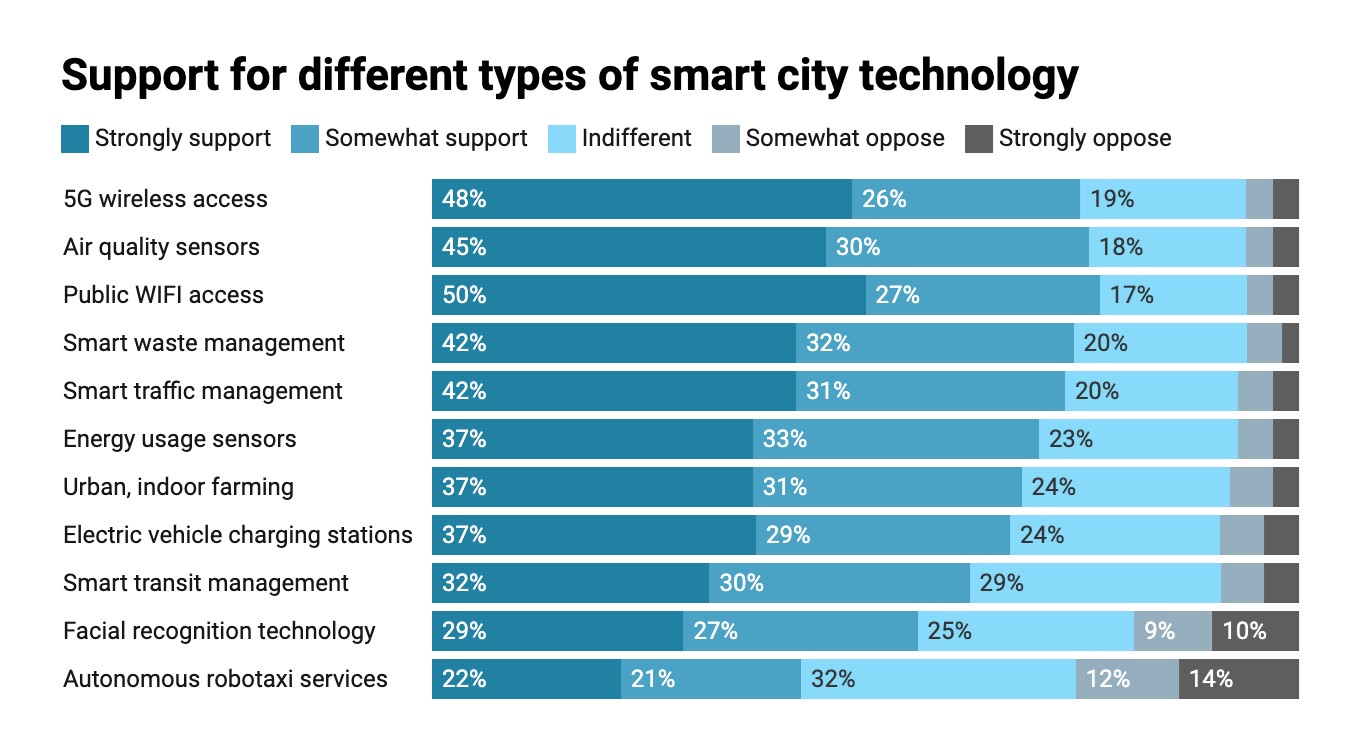
Panchawati has joined the Content and Strategy leadership team and will be based in Singapore
NEW YORK and SINGAPORE, Nov. 15, 2022 /PRNewswire/ — National Research Group (NRG), recognized as an insights leader at the edge of technology, content, and culture, today announced that Sushma Panchawati, a veteran insights strategist and emerging markets specialist, has been appointed Senior Vice President, Content & Strategy. She will oversee the firm’s presence in the Asia-Pacific (APAC) region. NRG is part of Stagwell (NASDAQ: STGW), the challenger network built to transform marketing.
In her new role, Panchawati will work closely with both existing and new clients across the streaming, television, and theatrical landscapes, leading brand health, concept evaluation, messaging and positioning, content testing, and creative material testing.
“Now is a really exciting time to be working on the content landscape in Asia-Pacific given the discernible impact it has been having on the world at large for the last decade. I am very excited to help our clients take it to new heights by tapping into the rich multi-cultural tapestry here and to be part of NRG’s journey in the region,” said Panchawati.
Panchawati has more than 15 years of experience working in product and marketing strategy. Most recently, she was part of the founding team at Edvanza, a career advancement partner for young professionals. There, she led the design and delivery of the company’s MVP product proposition, as well as the foundational business and marketing strategy, driving growth in the UK, Africa, and India. Before that, Panchawati led the APAC region for The Sound, a brand strategy and product innovation agency. She has led strategy and research efforts across APAC, EU, Africa, and South America working with brands like Google, Pinterest, Netflix, Amazon, and Apple on their brand launch campaigns, marketing and product strategies, and innovation pipelines.
“With established markets maturing, Asia-Pacific is a region of particular importance for many of our entertainment clients. However, its diverse range of cultures and tastes means that success will depend on bespoke marketing strategies. Sushma’s deep expertise and unique perspective across the region will be invaluable to our clients as they navigate the opportunities ahead,” said Stephen Palmer, President, Content & Strategy.
Panchawati earned her undergraduate degree from Jawaharlal Nehru Technology University and a master of business administration from MICA in India. She is a regular speaker at global conferences like the European Society for Opinion and Marketing Research (ESOMAR), highlighting her experience working across a diverse set of markets and methodologies. She will be based in Singapore.
National Research Group is a leading global insights and strategy firm at the intersection of entertainment and technology. Rooted in four decades of industry expertise, the world’s leading marketers turn to us for insights into growth and strategy for any content, anywhere, on any device. Working at the confluence of content, culture and technology, NRG offers insights for bold storytellers everywhere. To learn more, please visit www.nationalresearchgroup.com, and follow us on LinkedIn and Instagram.
Stagwell is the challenger network built to transform marketing. We deliver scaled creative performance for the world’s most ambitious brands, connecting culture-moving creativity with leading-edge technology to harmonize the art and science of marketing. Led by entrepreneurs, our 13,000+ specialists in 34+ countries are unified under a single purpose: to drive effectiveness and improve business results for their clients. Join us at www.stagwellglobal.com.
For NRG:
Mary Moczula
mary.moczula@nrgmr.com
For Stagwell:
Sarah Arvizo
pr@stagwellglobal.com
Related
Articles
In the News, Press Releases, Thought Leadership
Jun 10, 2025
Stagwell (STGW) Chairman and CEO Mark Penn to Discuss the Irreplaceable Power of Human Creativity on the Main Stage of Cannes Lions

Events, In the News, Press Releases, Talent & Awards
Jun 05, 2025
Code and Theory Named ANA B2B Agency of the Year After Transforming the World’s Leading Brands

In the News, Press Releases, Talent & Awards
May 19, 2025
Stagwell (STGW) Appoints Connie Chan as Chief Growth Officer for Asia Pacific

Newsletter
Sign Up
By: Ray Day
CONTACT:
We wanted to share our latest consumer and business insights, based on research from The Harris Poll, a Stagwell agency.
Among the highlights of wave 141 (fielded Nov. 4-6) in our weekly consumer sentiment tracking:
ECONOMY, INFLATION WORRIES TICK BACK UP:
Today, 88% of Americans are concerned about the economy, inflation and jobs – up 2 points from last week. Worries about affording living expenses, in particular, jumped significantly.
-
- 84% worry about a potential U.S. recession (up 1 point)
- 88% about the economy and inflation (up 2 points)
- 84% about U.S. crime rates (up 2 points)
- 76% about affording their living expenses (up 4 points)
- 75% about political divisiveness (up 1 point)
- 72% about the War on Ukraine (no change)
- 59% about a new COVID-19 variant (down 3 points)
- 48% about losing their jobs (down 6 points)
- 44% about the Monkeypox outbreak (down 4 points)
AMERICANS REGRET NOT SWITCHING JOBS SOONER:
Job seekers regret not starting their job searches sooner, as layoffs and freezes in tech threaten to expand to other sectors, according to our survey with Bloomberg.
-
- 71% of those looking to switch jobs say the job search today is more complicated than anticipated.
- 63% say they’ve searched for a new job for more than six months, and 48% report applying to more than 50 positions.
- 72% of job seekers say that companies are acting like they don’t want to hire, including ignoring applications and failing to schedule interviews.
- 66% say they regret not starting the search sooner, while 63% admit it would have been easier to switch jobs a year or two ago.
- 51% of job seekers agree that, at this point, they would take nearly any job offer.
TWITTER: A TALE OF MANY VIEWS:
In light of Elon Musk’s Twitter takeover, we find both critics and fans – something brands might want to remember as they consider pausing spending on the platform, according to our survey with USA Today.
-
- Female (63%) Twitter users are less likely to support Musk’s ownership than men (70%).
- Gen Z users also are more likely to believe Musk will hurt Twitter’s product quality (53%), freedom of the press (44%) and free speech on the internet (37%) compared with older users.
- Both women (28% willing) and Gen Z (35%) would be less willing to pay a monthly subscription fee than men (44%) and Millennials (53%).
- Yet 67% of Twitter users support Musk owning Twitter, especially Republicans (79%), parents with minor children (74%), urban residents (72%), men (70%) and Millennials (70%).
- 84% of Americans find free speech on social media important, and the majority of Republicans (57%), men (56%), rural (55%) and white Americans (53%) find it “very important.”
- Frequent Twitter users, including Republicans (42% versus Democrats at 32%), Millennials (40% versus Gen Z at 26%), men (36% versus women at 26%) and Black Americans (36% versus white at 32%) say they’ll now spend more time on the platform that Musk owns it (versus all Twitter users at 31%).
AMERICANS SAY SMART CITIES DON’T NEED AUTOMOUS TAXIS:
In partnership with Emerging Tech Brew, we found that 87% of city residents found it essential for their city to invest in emerging technologies – but not every resident supports each tech initiative equally.
-
- Most intelligent city technologies – such as public WiFi access, 5G wireless access, smart traffic management, facial recognition technology and air quality sensors – has solid support from city residents. The exception is autonomous robotaxi services, which less than half support (43%).
- Overall, Gen Z and Millennial city residents report being more aware of smart city tech, as well as much more likely to use the tech weekly compared to older residents (Gen Z 44% and Millennials 51% versus Gen X 37% and Boomers 16%).
- Those in cities with metro areas of less than 1 million tend to view such tech as less critical than their larger-city counterparts.
- Smaller-city residents also are less likely to view their cities as particularly innovative, with just 16% saying they find their city very innovative, compared to 43% for larger cities.
- 48% of Boomers said they never use smart city tech, while 27% of Gen X respondents said the same.
- That compares with only 13% of Millennials and 7% of Gen Z who say they never use smart city tech.
ICYMI:
In case you missed it, check out some of the thought-leadership and happenings around Stagwell making news:
As always, if helpful, we would be happy to provide more info on any of these data or insights. Please do not hesitate to reach out.
|
|
Thank you.
Related
Articles
In the News, Press Releases, Thought Leadership
Jun 10, 2025
Stagwell (STGW) Chairman and CEO Mark Penn to Discuss the Irreplaceable Power of Human Creativity on the Main Stage of Cannes Lions

Events, In the News, Press Releases, Talent & Awards
Jun 05, 2025
Code and Theory Named ANA B2B Agency of the Year After Transforming the World’s Leading Brands

In the News, Press Releases, Talent & Awards
May 19, 2025
Stagwell (STGW) Appoints Connie Chan as Chief Growth Officer for Asia Pacific

Newsletter
Sign Up
By: Ray Day
CONTACT:
We wanted to share our latest consumer and business insights, based on research from The Harris Poll, a Stagwell agency.
Among the highlights of wave 140 (fielded Oct. 28-Oct. 30) in our weekly consumer sentiment tracking:

ECONOMY, INFLATION WORRIES MODERATE; JOB WORRIES JUMP:
Today, 86% of Americans are concerned about the economy, inflation and jobs – down 3 points from last week. At the same time, worries about losing a job jumped significantly.
-
- 83% worry about a potential U.S. recession (down 2 points)
- 82% about U.S. crime rates (no change)
- 74% about political divisiveness (down 1 point)
- 72% about the War on Ukraine (down 2 points)
- 72% about affording their living expenses (no change)
- 62% about a new COVID-19 variant (up 1 point)
- 54% about losing their jobs (up 7 points)
- 48% about the Monkeypox outbreak (up 4 points)
INFLATION AT THE NORTH POLE:
Eight in 10 (84%) Americans plan to buy gifts for others this holiday season, and they have set their 2022 gift-giving budget at $823, according to our survey with NerdWallet.
-
- Close to a third (31%) of last year’s holiday shoppers are still in debt after using a credit card to pay for gifts they still haven’t paid off.
- 72% of this year’s holiday shoppers will use credit cards, charging $663 on average.
- Inflation is affecting how some shoppers approach gift-giving this year: 83% plan to adjust as a result of inflation, including giving different types of gifts compared to years past (36%) and spending less per person compared to years past (35%).
- 43% say they feel pressure to spend more money on holiday gifts than they’re comfortable spending.
- 68% plan to shop Black Friday/Cyber Monday sales this year.
- 50% say they’ll spend the most on gifts while shopping these sales.
- Still, 30% plan to use Black Friday/Cyber Monday sales to buy necessities for their home or family.
- 67% say they will do their holiday shopping online instead of in-store this year.
OPEN ENROLLMENT BELT-TIGHTENING:
It’s healthcare open-enrollment season, and many workers are considering downgrading their health insurance because of high inflation, according to our survey with the Nationwide Retirement Institute.
-
- 17% of respondents in the last 12 months adjusted their family’s budget to pay for health care expenses.
- 12% canceled or changed health insurance.
- 10% withdrew funds from their retirement account to pay for health care expenses.
- 8% downgraded their health insurance plan.
- 14% of Americans say they are considering downgrading their health insurance plan during this year’s open enrollment – rising to 23% for Gen Z and 20% for Millennials.
- Americans also are experiencing high levels of stress around retirement and retirement planning because of inflation: 47% report their top stressor is inflation, 30% worry about Social Security running out of funds, and 29% are concerned about an unexpected decline in their health.
EMPLOYEES’ ADVICE TO HR: LESS IS MORE:
When it comes to HR tech platforms to improve the work experience, less is more, according to our survey with HR Brew.
-
- On average, employees report using 3.4 HR platforms and 8.1 total HR and productivity tools in general.
- 69% of employees with one HR platform said they felt confident they could find the information they need.
- Confidence plummeted to 49% among those whose company has more than one HR platform.
- In today’s economic climate, employees have an appetite for financial planning solutions (80% favorability among Millennials and 72% among Gen X) and the lowest need for new social networking tools.
INTEREST IN WOMEN’S SPORTS CLIMBING:
The popularity of women’s sports has grown by leaps and bounds – and consumers want to see the trend continue, according to Stagwell’s National Research Group’s new report, Leveling the Playing Field.
-
- In the U.S., 3 in 10 sports fans say they’re watching more women’s sports now than they were five years ago.
- The broadcast market for women’s sports grew significantly worldwide this year, thanks in part to successful events like the UEFA European Women’s Championship and ICC Women’s Cricket World Cup.
- Even in the U.S., which didn’t compete in those tournaments, the market grew by 29% compared with 2021.
- 85% of fans – including 79% of men – think that it’s important for women’s sports to continue to grow in popularity.
- The Olympics proved there’s growing demand for women’s sports. During the Tokyo Games, in half of the 10 most widely viewed sports, viewership for women’s events was higher than men’s.
ICYMI:
In case you missed it, check out some of the thought-leadership and happenings around Stagwell making news:
As always, if helpful, we would be happy to provide more info on any of these data or insights. Please do not hesitate to reach out.
Related
Articles
In the News, Press Releases, Thought Leadership
Jun 10, 2025
Stagwell (STGW) Chairman and CEO Mark Penn to Discuss the Irreplaceable Power of Human Creativity on the Main Stage of Cannes Lions

Events, In the News, Press Releases, Talent & Awards
Jun 05, 2025
Code and Theory Named ANA B2B Agency of the Year After Transforming the World’s Leading Brands

In the News, Press Releases, Talent & Awards
May 19, 2025
Stagwell (STGW) Appoints Connie Chan as Chief Growth Officer for Asia Pacific

Newsletter
Sign Up
By
Connie Lin,
Fast Company
CONTACT
hello@stagwellglobal.com
SIGN UP FOR OUR INSIGHTS BLASTS
Nigeria sits at Africa’s heart: Geographically, it’s nestled middle-left of the curve in the kidney bean-shaped land mass, and its economy boasts the highest GDP on the continent (nearing $450 billion in 2021). The pulse of the country beats with the pace of rapid transformation. It harbors the world’s sixth-largest population, which is also among the fastest growing, projected to surpass the United States by 2050.
It’s a country of strivers, on the verge of reinventing itself—and it has fluxed socially and culturally in recent years. But one constant anchor is the promise of the internet in delivering a better future, reveals a new report from the National Research Group (NRG), a division of global marketing firm Stagwell.
Over the summer, NRG partnered with a media agency based in Lagos, the country’s largest city, to dive deep into the Nigeria’s shifting landscape—one that, despite its position at the heart of Africa, is still a mystery to much of the Western world (if not to the East—where it has caught the eye of economic powerhouses like China, which has poured millions into Nigerian infrastructure to cement strategic trade partnerships).
The report is the first in a series focusing on high-growth emerging markets, and draws from a June-July survey of 5,000 Nigerian consumers, ages 16 to 64, whose responses were interwoven with commentary from academics and industry experts. It sketches the portrait of a country reenergized by young blood, that has lagged on technological development in many ways, but now hopes to leapfrog into the digital race.
NEW DIGITAL NATIVES, CONNECTED BY SMARTPHONES
First and foremost, it notes: Nigeria runs on mobile technology. According to the data, 92% of people in the country own a smartphone, and the device dominates as a mode of entertainment for most. Over half (55%) of all TV shows and movies are watched on smartphones, and the vast majority (83%) of gaming is played on them as well. As NRG’s content and strategy executive Kerri Norton explains to Fast Company, this is partly out of economic necessity. Some Nigerians don’t have other devices for streaming. Laptop ownership is at 70%, and desktop computer ownership is significantly lower at 16%. Less than 30% own tablets or smart TVs, and only 15% own gaming consoles.
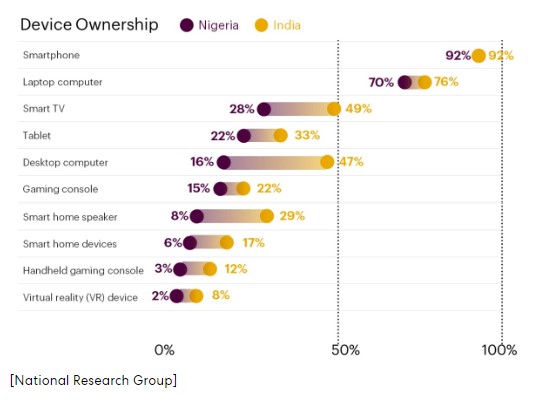
But beyond that, mobile is a godsend for Nigerians living with the state’s still relatively poor electricity infrastructure, says Samuel Odusami of SBI Media, the Nigeria-based agency that served as NRG’s local partner on the ground. “Because [Nigerians] don’t have access to uninterrupted power 24/7, mobile technology has become their savior,” says Odusami, adding that power-bank businesses have boomed in Nigeria, helping many stay wired to the internet for longer, on the road or at home, when the grid is down.
Consequently, the often-slow speed of internet is viewed as the biggest tech problem in the market, one that many hope the 5G revolution will solve. Nearly 70% of those surveyed are aware of the impending 5G rollout, and 81% of Nigerians believe it will “transform my country for the better.” In rural and low-income communities, where internet connections are spottiest, many believe 5G offers a chance to “catch up,” as faster streaming translates into more business productivity, the report notes.
“It’s a democratization of access across all socioeconomic classes,” says Anas Ghazi, Stagwell’s chief strategy officer. “It’s allowed for an entrepreneur mindset, as Nigeria [pursues] its largest revenue generation in the next five years.”
THE SKITMAKER HUSTLE
That entrepreneurial spirit of capitalism and “hustle culture” has long reigned in Nigeria, even as unemployment rates increased and the economy struggled. But now, it’s being supercharged by Nigeria’s largest population of youth in the world—skewing the country’s median age to just 18 years old—who have seized upon the internet as a way out of the well. “It’s a window of opportunity for young people,” says Odusami, who cites a rising generation of so-called skitmakers as proof.
Nigerian skitmakers create social media content, but they do it without the popular influencer luxuries—studios to shoot videos, or pricy tools for animation—choosing to invest only in a high-end smartphone, perhaps an iPhone or Samsung Galaxy, to stitch together content for YouTube, TikTok, and other platforms.
The goal is to go viral, and many have flocked to try. The country now has a nest of creators numbering in the thousands—including some with millions of views, says Odusami—who have used their success as a springboard to start full-fledged production companies, even in the mainstream movie industry. Collectively, skitmaker startups employ close to 5,200 people, he says. Among the most prominent is Mr Macaroni, who broke through with YouTube comedy and now tours the world promoting Nigerian issues.
For those who don’t strike it big, skitmaking might be just one of many enterprises. “Even people with 9 to 5 jobs have what we call ‘side hustles,’” says Odusami. “In Nigeria, you can’t [support] a family without multiple streams of income.” They might start blogs or YouTube channels, or they might start a business that has nothing to do with social media—but the internet remains a through line. Learning to code, or leveraging e-commerce to sell Nigerian cuisine in foreign countries, are among the examples he cites.
But despite the hustle, Nigerians still feel “behind” on tech development, NRG’s report finds. Only one in three survey respondents said their country was currently “very innovative,” compared to over half of respondents in India, which served as a pseudo-control group for the study.
According to Odusami, Nigerians hope the grind can help bridge the gap. “They are hungry to feed themselves,” he says. “Hungry to make a name, hungry to become financially independent.”
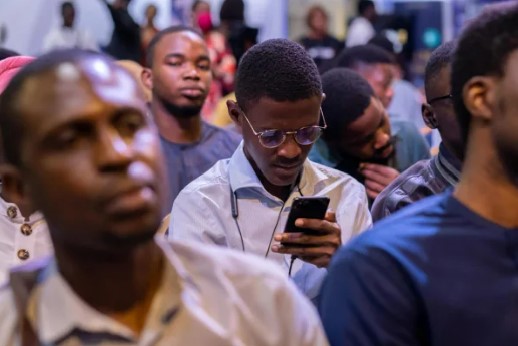
CRYPTO UNLOCKED
As businesses grew, Nigerians needed a way to accept payments globally—something that wasn’t possible with PayPal, Google Pay, or other legacy platforms. That ignited a boom in enthusiasm for cryptocurrencies and blockchain technology, one that has dwarfed awareness of crypto in the United States. In Nigeria, 90% responded that they were aware and knowledgeable about cryptocurrencies, while 71% said the same for the blockchain and 59% for NFTs. (In a November 2021 Pew Research report, only 24% of Americans said they had heard “a lot” about crypto.)
“Now you have businesses who accept payments in crypto, in stablecoins like USDC and Binance Coin,” says Odusami. But even as people began to adopt crypto for everyday goods like groceries and taxi rides, the Nigerian government’s central bank in 2021 began to restrict Bitcoin services in the country. According to a recent joint report from the Organisation for Economic Co-Operation and Development (OECD) and the United Nations, the crackdown crippled “millions of young Nigerians” who were making money from crypto trading. However, the report also suggested that some found a way to “lawfully bypass these restrictions and continue the business.” The same month, crypto exchange KuCoin reported that 33 million Nigerians had owned or traded crypto in the last half year.
According to Odusami, 20 to 30 global crypto exchanges have a presence in Nigeria and are actively targeting Nigerian customers—including Binance, which is a client of SBI Media in five African countries.
Meanwhile, the hustle has moved onto the blockchain. Odusami cites the story of a Nigerian man who created his own NFT project from photos of drummers at a traditional Nigerian wedding ceremony—a cultural rite beloved not just in dance, but also as a musical retelling of the betrotheds’ mothers and fathers through the years. The man made a killing—and returned to the ceremonial village to give the drummers 70% of the proceeds.
BIG TECH’S SWAY
According to the survey, Silicon Valley Big Tech companies (including social media) wield tremendous influence in Nigeria, with their command of the culture second only to religious institutions. It tops that of colleges and universities, as well as the government, and both Hollywood and Nollywood.
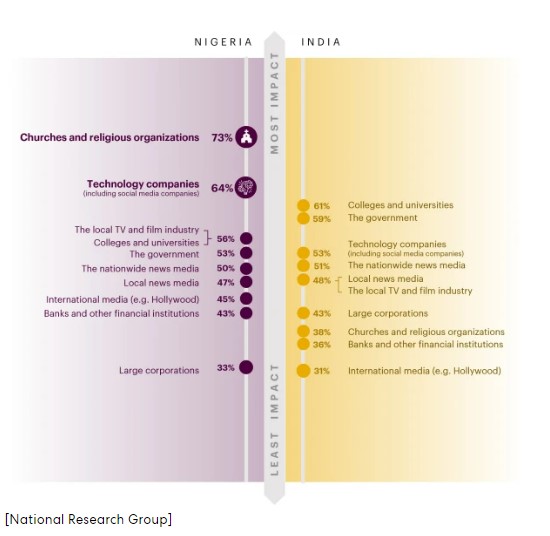
It’s perhaps no surprise that giants of crypto and social media—which have speckled reputations in the States—are viewed much more positively in Nigeria, because, as Norton explains, the impact of both technologies within the country has been overwhelmingly positive. It offers freedom of entrepreneurship and liberation from circumstances, a lifeline that keeps Nigerians afloat, and working, and connecting with the rest of the world. It might even have the power to combat corrupt governments and state overreach.
But Nigeria is young, and it will still have to fight for its place in a competitive world. “Nigeria is on the map to grow significantly over the next 10, 15, even 5 years,” says Norton. “They want to be where the future is.”
So, it hustles on.
Related
Articles
Artificial Intelligence, In the News, Marketing Frontiers, Press Releases, Stagwell Marketing Cloud, Tech
Jun 12, 2025
PRophet, a Stagwell (STGW) Company, Completes Integration of UNICEPTA, Launches Unified Brand and Enhanced Media Intelligence Offering

In the News, Marketing Frontiers, Press Releases, Stagwell Marketing Cloud, Tech
Jun 11, 2025
The Marketing Cloud Launches Cutting-Edge Platform to Simplify Marketing Workflows
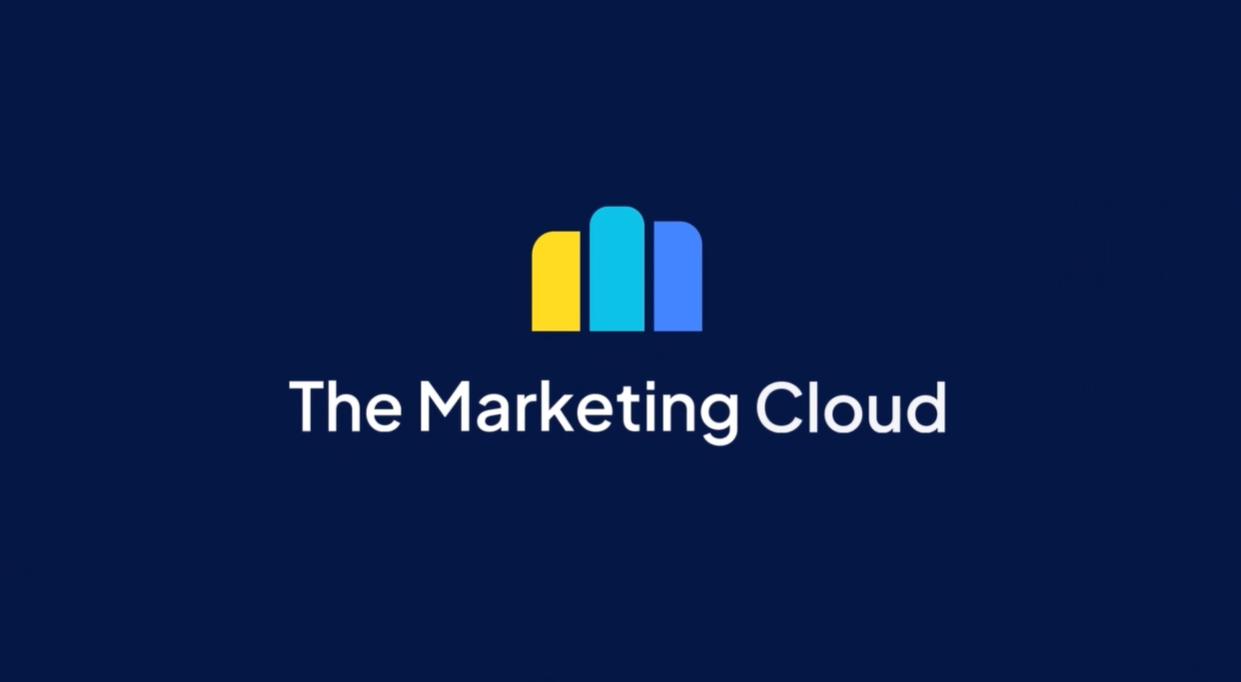
In the News, Press Releases, Thought Leadership
Jun 10, 2025
Stagwell (STGW) Chairman and CEO Mark Penn to Discuss the Irreplaceable Power of Human Creativity on the Main Stage of Cannes Lions

NRG Releases Whitepaper, “The Power of Brand Fandom: 5 Things to Know Right Now”
NEW YORK, Oct. 31, 2022 /PRNewswire/ — Research from Stagwell‘s (NASDAQ: STGW) National Research Group (NRG), a global insights leader at the intersection of technology, content, and culture, shows more people are fans of brands, products, and services in the same way they love sports and celebrities. NRG introduced its “Brand Fandom” research focus at Advertising Week, beginning a series that will unpack the journey to fandom across key categories and audiences. The research will explore the pathways for brands to successfully build and activate a fan community and understand the modern-day fan ecosystem.
NRG’s Brand Fandom showed up in a myriad of ways this month:
- Brand Fandom Whitepaper: In a new report, “The Power of Brand Fandom: 5 Things to Know Right Now,” research points to brand influence as being more significant than other commonly associated areas of interest: consumers are bigger fans of brands or products (57%) than of celebrities (54%), movies (52%), sports (48%) or online influencers/personalities (37%). Some other key themes from the paper include:
- Age is just a number: Brand fandom is strong across all ages, dispelling conventional assumptions that Gen Z and millennials have a fleeting sense of brand loyalty.
- Fans don’t exist in a vacuum: 54% “want everyone to know” they are a fan of a given brand or product.
- Brand fans are sold on potential, too. Over three-quarters (77%) say they will at least try different products the brand comes out with.
- MediaPost Op-Ed: In a contributed piece, Stagwell Global Chief Marketing Officer Ryan Linder and NRG EVP, Brand Strategy and Innovation Fotoulla Damaskos co-bylined an article, “Bigger Than Sports and Celebrity: The Power of Brand Fandom,” which explores what brands can expect of the consumers who they turn into fans: not just deep loyalty, but advocacy.
- Advertising Week New York: A panel at AWNY, which included NRG’s Damaskos and EVP, Head of Sports Marketing Jay Kaufman; Stagwell’s Linder; Christie’s SVP, Head of Marketing Neda Whitney; and McDonald’s Director, Communications Measurement & Insights Sarah Myles, introduced brand fandom on “Buzz and Devotion: The Fan Economy That Makes Niche Mainstream in Today’s Culture.”
“This first piece of research shows how brand fandom serves as a tool of self-expression, intricately linking brands to consumer identities. It should signal to brands that interactions with customers have to be dialogues, nurturing people’s experiences and engendering a sense of shared belonging,” said NRG EVP, Brand Strategy & Innovation Fotoulla Damaskos. “Our choices as consumers are on full display right now – we can wield power against the brands that fail us, or passionately champion those we believe in. Where these choices fall can mean the difference between having customers or having fans who bring commitment, advocacy and long-term brand growth.”
“The way I move about the world – how I approach the fast-paced work of brand marketing, to the even faster-paced world of fatherhood – I’ve done through the lens of authenticity and grit, qualities I adopted from my fandom for Harley-Davidson motorcycle culture,” said Stagwell EVP, CMO Ryan Linder. “My identity continues to be reinforced by a kaleidoscope of brands I’m personally invested in, proof that the influence of brands can manifest across so many aspects of our lives.”
Data used in this report comes from a study of 1,018 US consumers, ages 18 to 65, conducted in October 2022–representative of the national population in terms of age, gender and ethnicity.
National Research Group is a leading global insights and strategy firm at the intersection of entertainment and technology. Rooted in four decades of industry expertise, the world’s leading marketers turn to us for insights into growth and strategy for any content, anywhere, on any device. Working at the confluence of content, culture and technology, NRG offers insights for bold storytellers everywhere. To learn more, please visit www.nationalresearchgroup.com, and follow us on LinkedIn and Instagram.
Stagwell is the challenger network built to transform marketing. We deliver scaled creative performance for the world’s most ambitious brands, connecting culture-moving creativity with leading-edge technology to harmonize the art and science of marketing. Led by entrepreneurs, our 13,000+ specialists in 34+ countries are unified under a single purpose: to drive effectiveness and improve business results for their clients. Join us at www.stagwellglobal.com.
Stagwell’s fastest-growing network transforms for the convergence of creative, media, and commerce.
Related
Articles
In the News, Press Releases, Thought Leadership
Jun 10, 2025
Stagwell (STGW) Chairman and CEO Mark Penn to Discuss the Irreplaceable Power of Human Creativity on the Main Stage of Cannes Lions

Events, In the News, Press Releases, Talent & Awards
Jun 05, 2025
Code and Theory Named ANA B2B Agency of the Year After Transforming the World’s Leading Brands

In the News, Press Releases, Talent & Awards
May 19, 2025
Stagwell (STGW) Appoints Connie Chan as Chief Growth Officer for Asia Pacific

Newsletter
Sign Up
By
Harris Brand Platform
CONTACT
hello@stagwellglobal.com
SIGN UP FOR OUR INSIGHTS BLASTS
A Size-Inclusive Rollout Shrinks Earnings, but Not Brand Equity
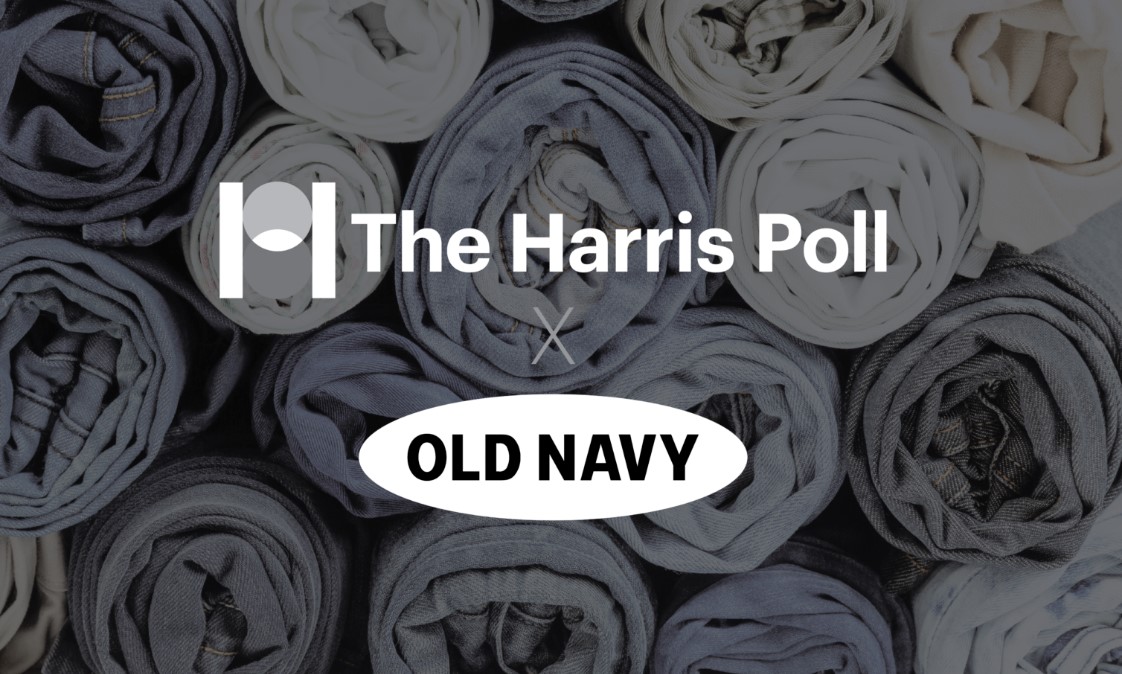
In August 2021, Old Navy launched BODEQUALITY, a campaign that expanded their clothing line to serve women sizes 00-30. Inventory mismanagement resulted in financial losses; however, Harris Brand Platform data shows that this “failure” comes with a silver lining:
- BODEQUALITY departed from the traditional women’s clothing market, with apparel specifically designed for curvy women and a strategy focused on size inclusivity.
- The right idea…Consumers familiar with the Old Navy brand appreciated BODEQUALITY’s mission, and the retailer’s brand equity hit a November high.
- …The wrong execution: Inventory mismanagement, and supply chain issues, resulted in stores overwhelmed with surpluses of the largest and smallest sizes, and a lack of their most popular mid-range sizes.
Download our case study to discover how consumers responded to Old Navy’s BODEQUALITY campaign, and how this “failure” also did the brand some good.
Related
Articles
Artificial Intelligence, In the News, Marketing Frontiers, Press Releases, Stagwell Marketing Cloud, Tech
Jun 12, 2025
PRophet, a Stagwell (STGW) Company, Completes Integration of UNICEPTA, Launches Unified Brand and Enhanced Media Intelligence Offering

In the News, Marketing Frontiers, Press Releases, Stagwell Marketing Cloud, Tech
Jun 11, 2025
The Marketing Cloud Launches Cutting-Edge Platform to Simplify Marketing Workflows

In the News, Press Releases, Thought Leadership
Jun 10, 2025
Stagwell (STGW) Chairman and CEO Mark Penn to Discuss the Irreplaceable Power of Human Creativity on the Main Stage of Cannes Lions

Newsletter
Sign Up
By: Ray Day
CONTACT:
We wanted to share our latest consumer and business insights, based on research from The Harris Poll, a Stagwell agency.
Among the highlights of wave 139 (fielded Oct. 21-Oct. 23) in our weekly consumer sentiment tracking:
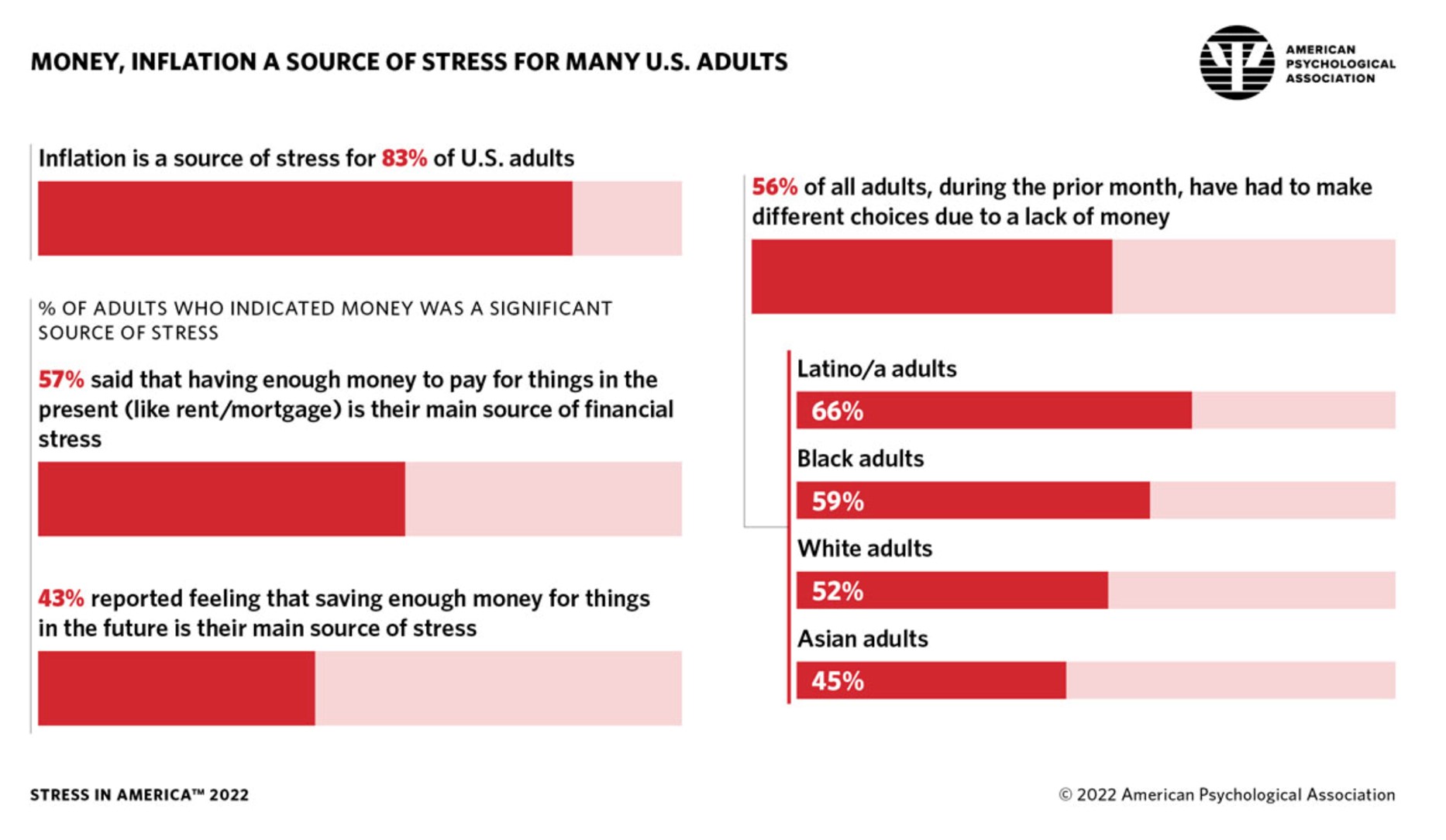
ECONOMY, INFLATION WORRIES REMAIN STEADY:
Today, 89% of Americans are concerned about the economy, inflation and jobs – the same high level as last week.
-
- 85% worry about a potential U.S. recession (no change)
- 82% about U.S. crime rates (down 1 point)
- 75% about political divisiveness (up 1 point)
- 74% about the War on Ukraine (no change)
- 72% about affording their living expenses (down 1 point)
- 61% about a new COVID-19 variant (up 1 point)
- 47% about losing their jobs (no change)
- 44% about the Monkeypox outbreak (down 4 points)
INFLATION IS AMERICA’S #1 STRESSOR:
How stressed are Americans, and what’s causing it? The answers are clear in the 2022 Stress in America survey we conducted with the American Psychological Association.
-
- 27% of Americans report being so stressed that they cannot function most days.
- Inflation is the #1 stressor for 83% of adults. That is followed by violence and crime (75%), the current political climate (66%) and the racial climate (62%).
- 76% say the future of the nation is a significant source of stress in their lives.
- 68% say this is the lowest point in our nation’s history that they can remember.
- 57% who indicated money was a worry said that having enough money to pay for things like food or rent/mortgage is their main source of stress.
- 43% reported feeling that saving enough money for things in the future is their main source of stress.
- 56% agreed that they and/or their family have had to make different choices due to lack of money in the past month, with Latino/a (66%) and Black Americans (59%) reporting this at a higher level than White (52%) and Asian (45%) American adults.
EMPLOYEES WARMING UP TO BACK-TO-OFFICE:
As we continue tracking return-to-office requirements, a majority of employees still say they will jump jobs if forced back to the office full-time. Yet the numbers of workers resisting return-to-office are much lower than three months ago, based on our survey with USA Today.
-
- 57% of employed Americans say companies will lose employees if they require workers to be in-person (down 9 points from June).
- 73% of remote and hybrid workers say they would find another remote or hybrid job if their company forced them to work from the office full-time (down 5 points from June).
- In an earlier study with Bloomberg, 57% of workers said they believe that employers now have more power in the job market (a 5-point increase in favor of employers from January).
INFLUENCERS MATTER:
Nearly half of U.S. consumers consider input from influencers when purchasing a product or service – especially younger people, according to our survey with AdAge.
-
- 80% of Gen Z consult user reviews before purchasing, and 75% say that recommendations from influencers affect their decision – nearly double the general population at 43%.
- 40% of Gen Z members have made purchases directly through an influencer’s storefront on sites like Amazon and LTK.
- 73% also report looking to TikTok creators for product input, with Instagram and YouTube influences being similarly popular choices.
BRANDS GETTING GEN Z RIGHT:
Beats by Dre, Jersey Mike’s Subs, Planned Parenthood, Lenovo and New Balance are doing the right things to capture the attention of Gen Z, according to the latest Ad Age-Harris Poll Gen Z brand tracker, a ranking of brands gaining the most attention from Gen Z members ages 18-24 in the third quarter.
-
- Also doing better with Gen Z are Kickstarter, Impossible Foods, Coach, Flex Seal, Foot Locker, Pillsbury, Haagen-Dazs, Bose, Nature Valley, North Face, Crocs, NHL, Paramount, Fiji and State Farm.
- See full details here.
ICYMI:
In case you missed it, check out some of the thought-leadership and happenings around Stagwell making news:
As always, if helpful, we would be happy to provide more info on any of these data or insights. Please do not hesitate to reach out.
Thank you.
Related
Articles
In the News, Press Releases, Thought Leadership
Jun 10, 2025
Stagwell (STGW) Chairman and CEO Mark Penn to Discuss the Irreplaceable Power of Human Creativity on the Main Stage of Cannes Lions

Events, In the News, Press Releases, Talent & Awards
Jun 05, 2025
Code and Theory Named ANA B2B Agency of the Year After Transforming the World’s Leading Brands

In the News, Press Releases, Talent & Awards
May 19, 2025
Stagwell (STGW) Appoints Connie Chan as Chief Growth Officer for Asia Pacific

Newsletter
Sign Up
CONTACT
hello@stagwellglobal.com
SIGN UP FOR OUR INSIGHTS BLASTS
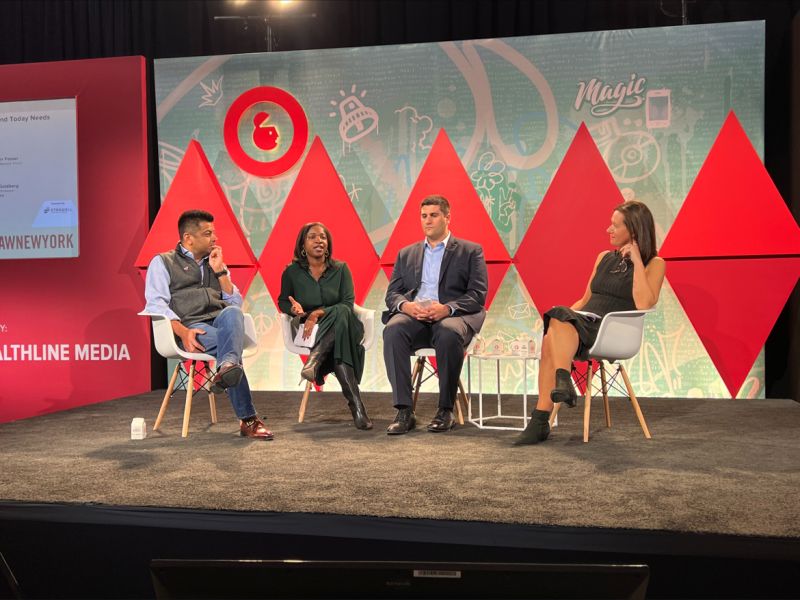
Missed Advertising Week New York this week? We distill the biggest brand takeaways on brand fandom, political advertising, and media channel transformations below. Follow Stagwell on LinkedIn to keep up with the insights.
Rise of Brand Fandom – Move over, sports teams and celebrities.
Fifty-seven percent of consumers consider themselves a fan of a brand or product – higher than sports (48%), movies (52%), celebrities (54%), or online influencers/personalities (37%).
The brands that take a holistic stake in consumers’ lives will drive loyalty, affinity, and advocacy–and not just in the moment. Fandom is not a fad or a flash in the pan; 2 in 5 brand fans have been fans for over 10 years. Focus on helping consumers develop their personalities through your brand by delivering marketing, events and experiences, and content that gives them a platform to express that personality.
“Fandom is critical in the luxury space. Luxury is no longer defined as the most expensive thing –it’s defined by insider knowledge. We’re seeing a dispersion of brands being considered ‘wealth’ and ‘luxury,’ and price point alone won’t keep you in that luxury equity space. It’s important to have fan bases that really think of your brand as luxury.” – Neda Whitney, SVP, Head of Marketing, Americas, Christie’s
Political is the Biggest Media Story of 2022 – Get ready for hotter cyclical media environments as political advertisers diversify digital media channels to engage more voters.
Brands will feel the effect of political messaging as political advertisers spend a record $3 billion in the last three weeks of the election alone.
Many ads will tell Americans they’re poorer than ever because of inflation, for example – how will brands push back and get consumers to continue spending? Brands can no longer afford to be apolitical but risk looking too performative if they don’t back up their positions with actions. Lyft decided to foreground its identity as a transportation company when deciding to act, and as a result, it has provided ride services for voting, vaccines, and reproductive rights.
“We saw in 2016 that so many people chose not to vote because they didn’t have access to transportation. So we asked ourselves: how can we make an impact there? We created a voter access program and saw its immediate impact in 2020. It’s about looking at the issues consumers care about and our services. It’s our job to listen – to talk to elected officials and let them know we can come in as a partner to solve some of the issues our consumers care about.” – Heather Foster, Head of Government Affairs, Lyft
Digital Channels and Political Advocacy – Are political advertisers about to have the digital marketing efficacy reckoning?
This cycle will be the first many realize media buys are not driving impact because of mistargeting. Many voters in battleground districts no longer have traditional television – but there’s a disconnect between ad spending and consumption, with most dollars still going to broadcast. Brands need to get more comfortable shifting the media mix and taking risks with bourgeoning digital channels.
“The idea that there’s the TV generation and then there’s the kids – it’s an antiquated view. The fact is cord cutting is mainstream – now the majority of the population – and the idea that we can say we have a TV strategy and a different digital strategy is fraught with disaster. As we iterate, brands need to think about messaging across the full funnel, and know that TV and streaming work really well together because it allows us to do that. The future will be integrated streaming and linear in a really incremental fashion.” – Ashwin Navin, CEO SambaTV
Resurgence of OOH – OOH is resurging because OOH is modern.
When you start treating it like programmatic or digital it becomes a valuable tool in the funnel. Driving consumer engagement and social amplification through use of the OOH medium. (The Harris Poll found TikTok and other social media platforms are a major source of OOH ad visibility: 82% of TikTok users report frequently noticing OOH ads in content in their feeds, with nearly identical impact reported by Facebook and Instagram users.) And don’t sleep on the innovation underway here: location-based insights, shared AR capabilities, and more are all letting advertisers do more at scale. Embrace the underlying technology capabilities of Out of Home as a resilient pillar of your media plan for 2023.
”Out of home isn’t changing – the strategy is. Media is the new experiential and Out of Home is where people are. The technology that sits behind Out of Home is driving a different strategy lens, a different creative lens, and a different content lens.” – Brad Simms, CEO, GALE Partners.
Related
Articles
Artificial Intelligence, In the News, Marketing Frontiers, Press Releases, Stagwell Marketing Cloud, Tech
Jun 12, 2025
PRophet, a Stagwell (STGW) Company, Completes Integration of UNICEPTA, Launches Unified Brand and Enhanced Media Intelligence Offering

In the News, Marketing Frontiers, Press Releases, Stagwell Marketing Cloud, Tech
Jun 11, 2025
The Marketing Cloud Launches Cutting-Edge Platform to Simplify Marketing Workflows

In the News, Press Releases, Thought Leadership
Jun 10, 2025
Stagwell (STGW) Chairman and CEO Mark Penn to Discuss the Irreplaceable Power of Human Creativity on the Main Stage of Cannes Lions

Newsletter
Sign Up
Epicenter Experience is Stagwell Marketing Cloud’s 3rd Acquisition in 2022, Adding Mobile and Location Data to its Evolving Data and Insights Stack
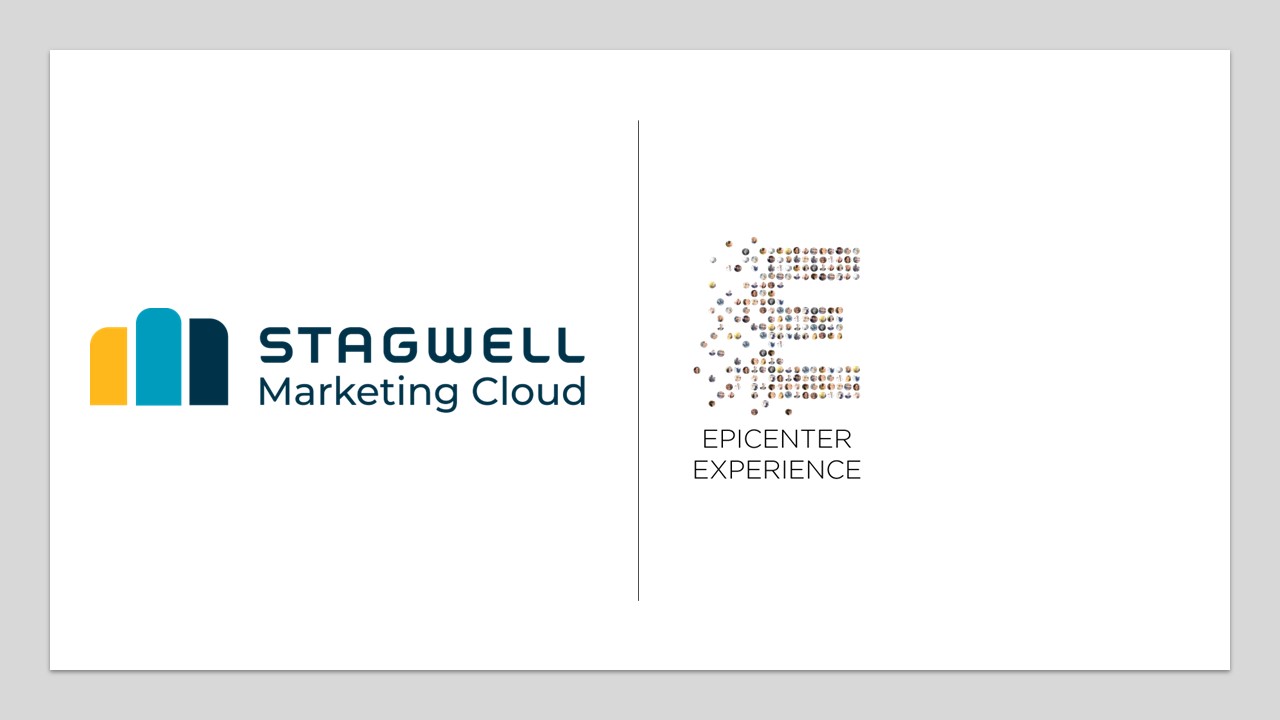
NEW YORK and BOSTON, Oct. 19, 2022 /PRNewswire/ — Stagwell (NASDAQ: STGW), the challenger network built to transform marketing, has acquired Epicenter Experience (Epicenter), an enterprise software company that leverages mobile and location data to map and sequence complex consumer behavior patterns. Epicenter will become part of the Stagwell Marketing Cloud (SMC), a proprietary suite of software-as-a-service (SaaS) and data-as-a-service (DaaS) products built for in-house marketing teams.
“We have strong momentum building around the Stagwell Marketing Cloud’s insights and analytics capabilities, and we’re excited to add Epicenter’s location-focused platform as another supplement to our data stack,” said Stagwell Chairman and CEO Mark Penn. “With this AI-powered technology, we can deliver more comprehensive data intelligence to brands, helping them more effectively drive customer acquisition and retention goals.”
“With The People Platform we’ve built a tool that provides contextual awareness and behavioral understanding on a granular level, providing our clients with a connective tissue that they’ve come to view as a ‘currency service.’ We look forward to enhancing the SMC with this technology that can be applied within any industry,” said Epicenter Experience CEO and Co-founder Paul Krasinski. “Through these direct-from-consumer learnings we empower our customers across retail, healthcare, consumer goods, sports, entertainment and more to create more valuable, more personalized connections to their audiences at scale.”
SMC has been actively investing in emerging technologies and data-focused platforms as part of its strategy to serve in-house teams with transformative marketing technology capabilities. This is the SMC’s third acquisition in the second half of 2022, following Apollo Program in July and Maru Group in October. Epicenter will continue to be led by its current leadership team including Co-founders CEO Paul Krasinski and CFO Lynne Lipinsky.
Terms of the deal were not disclosed.
Stagwell is the challenger network built to transform marketing. We deliver scaled creative performance for the world’s most ambitious brands, connecting culture-moving creativity with leading-edge technology to harmonize the art and science of marketing. Led by entrepreneurs, our 13,000+ specialists in 34+ countries are unified under a single purpose: to drive effectiveness and improve business results for their clients. Join us at www.stagwellglobal.com.
Related
Articles
In the News, Press Releases, Thought Leadership
Jun 10, 2025
Stagwell (STGW) Chairman and CEO Mark Penn to Discuss the Irreplaceable Power of Human Creativity on the Main Stage of Cannes Lions

Events, In the News, Press Releases, Talent & Awards
Jun 05, 2025
Code and Theory Named ANA B2B Agency of the Year After Transforming the World’s Leading Brands

In the News, Press Releases, Talent & Awards
May 19, 2025
Stagwell (STGW) Appoints Connie Chan as Chief Growth Officer for Asia Pacific

Newsletter
Sign Up
By: Ray Day
CONTACT:
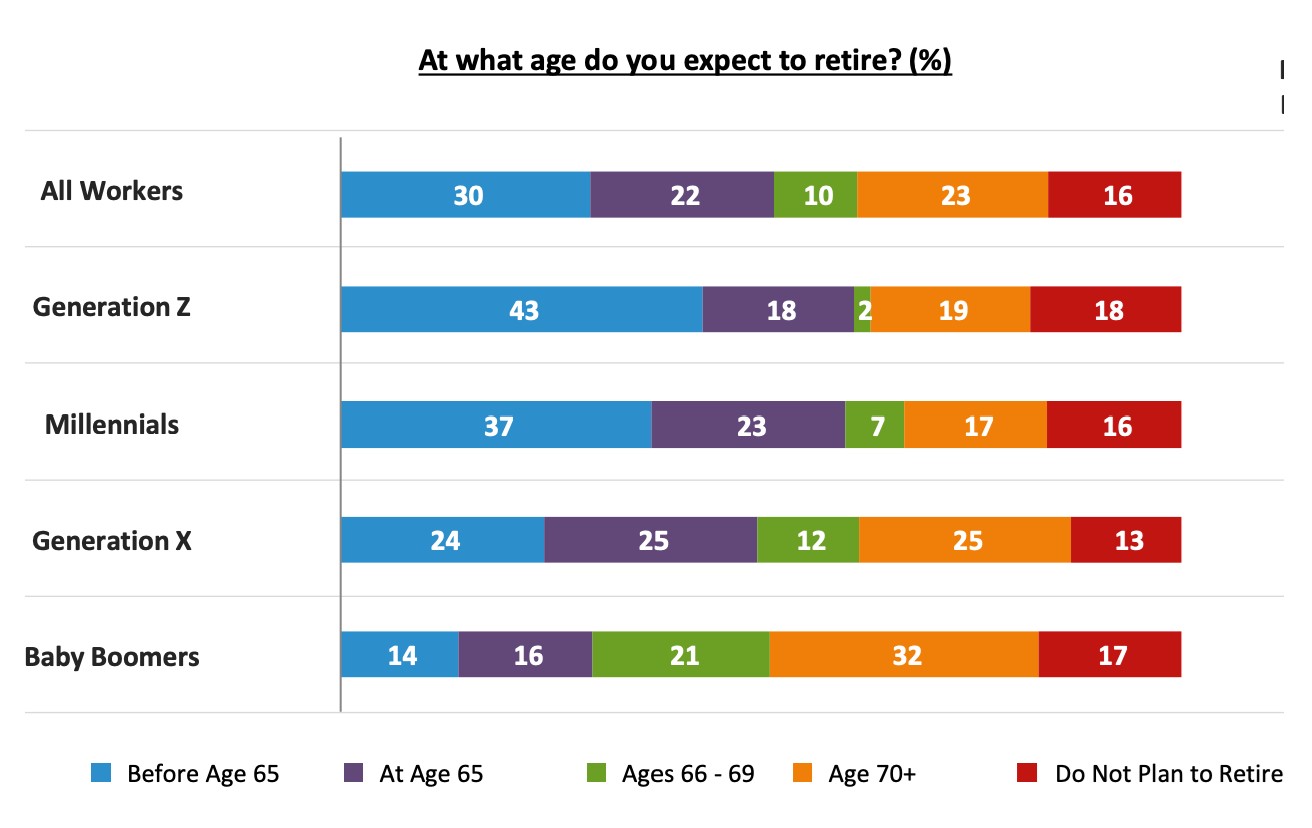
- JOB, COST-OF-LIVING WORRIES UP AGAIN: Today, 86% of Americans are concerned about the economy, inflation and jobs – moderating from last week. Yet worries about affording living expenses and losing a job are on the rise again.
- 86% are concerned about the economy and inflation (down 4 points from last week)
- 82% about a potential U.S. recession (down 4 points)
- 81% about U.S. crime rates (down 1 point)
- 73% about political divisiveness (down 1 point)
- 73% about affording their living expenses (up 1 point)
- 73% about the War on Ukraine (no change)
- 57% about a new COVID-19 variant (down 2 points)
- 48% about losing their jobs (up 3 points)
- 47% about the Monkeypox outbreak (up 2 points)
- GEN Z NOT BANKING ON SOCIAL SECURITY: Of the four generational groups currently in the working world, Gen Z is the least likely to depend on Social Security to fund their retirement – and the most likely to retire early. That’s according to the “Emerging From the COVID-19 Pandemic: Four Generations Prepare for Retirement” survey released this week with the Transamerica Center for Retirement Studies.
- Gen Z workers (43%) are more likely than older generations to expect to retire before age 65 (versus 30% of all workers expecting to retire before age 65, 37% for Millennials, 24% for Gen X and 14% for Baby Boomers).
- 67% of Gen Z workers are saving for retirement through employer-sponsored 401(k) or similar retirement plans or outside the workplace.
- The median age at which Gen Z is starting to save – 19 years old – is much younger than the median starting age for Millennials (age 25), Gen X (30) and Boomers (35).
- Among Gen Z and Millennials, 73% said they are concerned that Social Security will not be there when they are ready to retire.
- That compares with 40% of Boomers who expect Social Security to be their primary source of retirement income.
- Gen X workers have the least faith in Social Security, with 78% saying they are concerned that Social Security will not be there for them when they are ready to retire.
- HIGH SCHOOLERS WANT MORE CAREER HELP: High school students across the country are frustrated with the lack of support they are receiving in preparing for a future career. Our survey with the Data Quality Campaign and Kentucky Student Voice Team found:
- 54% say the pandemic has changed how they think about what they might do after graduation.
- Only 35% say their school informed them of which postsecondary or career paths are available to them.
- 80% of students agree they would feel more confident about their career path if they had better access to information to determine their options after graduation.
- This lack of career preparation already is showing up in the workplace. Of Gen Z members who interned or started a job this past year, 49% say that they did not feel like their training and onboarding were done well.
- 58% of interns also report feeling lost at work without anyone to reach for questions and support.
- LESS THAN HALF OF VOTING AMERICA WATCHES TRADITIONAL TV: When it comes to reaching Americans this election season, less than half of voters (49%) have a traditional TV, according to a new HarrisX survey with Samba TV.
- 1 in 4 of those who do still have traditional TV plan to cancel in the next six months.
- Independents (42%) are the least likely to have traditional TVs.
- Millennial and Gen Z voters are more than twice as likely to stream than they are to have a traditional linear subscriptions today. The gap is even wider for younger voters in battleground states.
- Facebook remains the most used platform by registered voters nationally but has less of an impact in key battleground states.
- Democrat voters are significantly more likely to use TikTok than Republicans nationally –with 37% of Democratic voters using it weekly compared with 27% of Republican voters.
- MANY WOMEN STILL MISS DEADLY BREAST CANCER SIGNS: October is National Breast Cancer Awareness Month, and most women are unaware of the unusual symptoms of a particularly aggressive and deadly form of the disease, according to our survey with The Ohio State University Comprehensive Cancer Center.
- The good news: 78% of women recognize a lump in the breast as a sign of breast cancer.
- However, less than half of women would flag redness of the breast (44%), pitting/thickening of the skin (44%) or one breast feeling warmer or heavier than the other (34%) as possible symptoms of breast cancer – specifically the rare and highly aggressive form of the disease known as inflammatory breast cancer.
- ICYMI: In case you missed it, check out some of the thought-leadership and happenings around Stagwell making news:
As always, if helpful, we would be happy to provide more info on any of these data or insights. Please do not hesitate to reach out.
Related
Articles
In the News, Press Releases, Thought Leadership
Jun 10, 2025
Stagwell (STGW) Chairman and CEO Mark Penn to Discuss the Irreplaceable Power of Human Creativity on the Main Stage of Cannes Lions

Events, In the News, Press Releases, Talent & Awards
Jun 05, 2025
Code and Theory Named ANA B2B Agency of the Year After Transforming the World’s Leading Brands

In the News, Press Releases, Talent & Awards
May 19, 2025
Stagwell (STGW) Appoints Connie Chan as Chief Growth Officer for Asia Pacific


